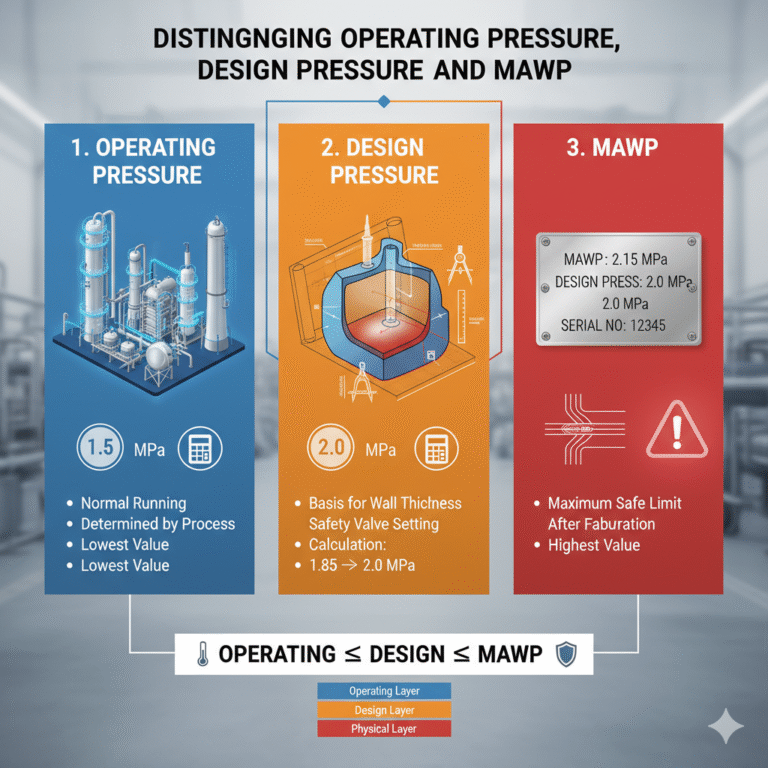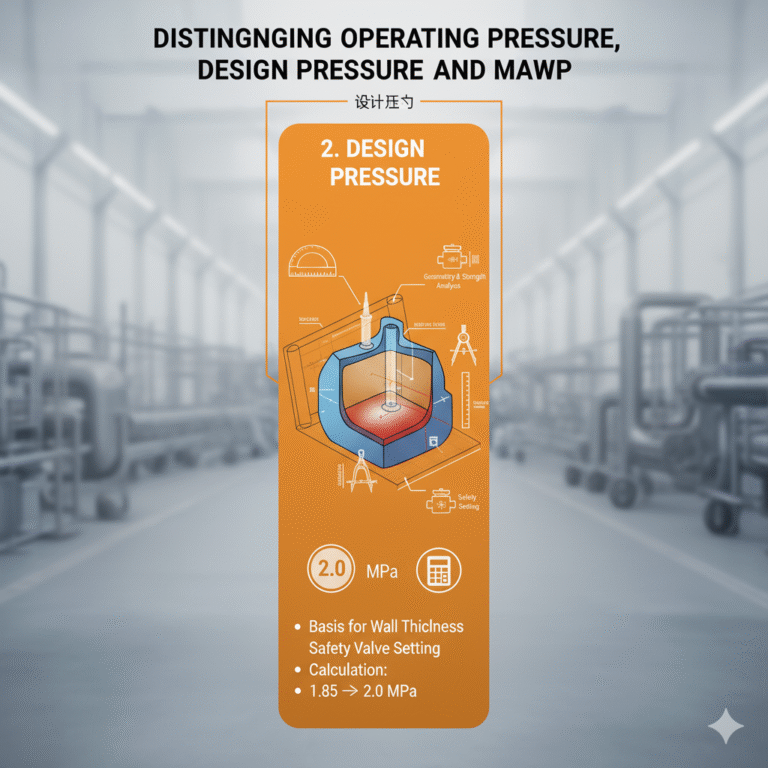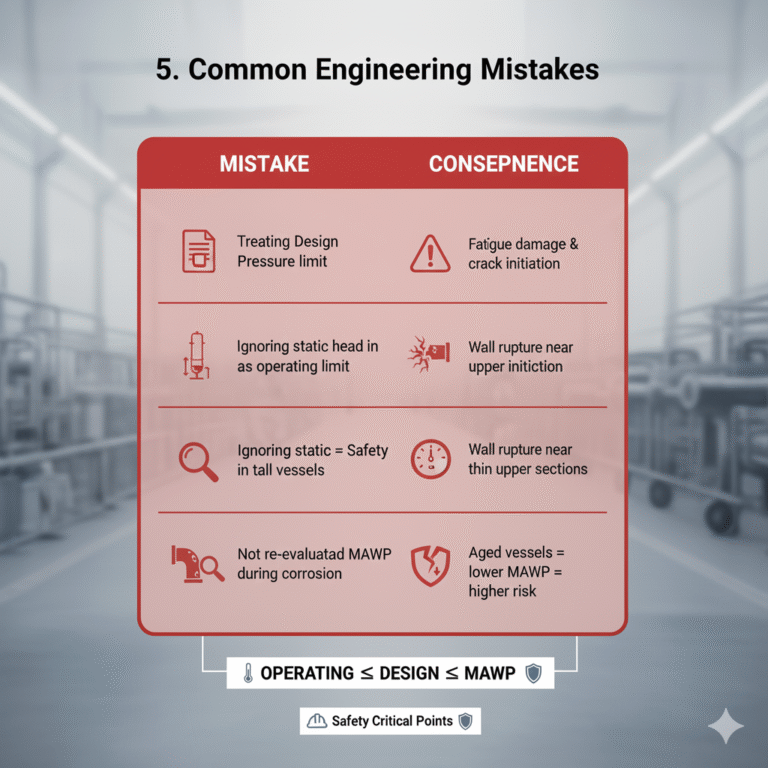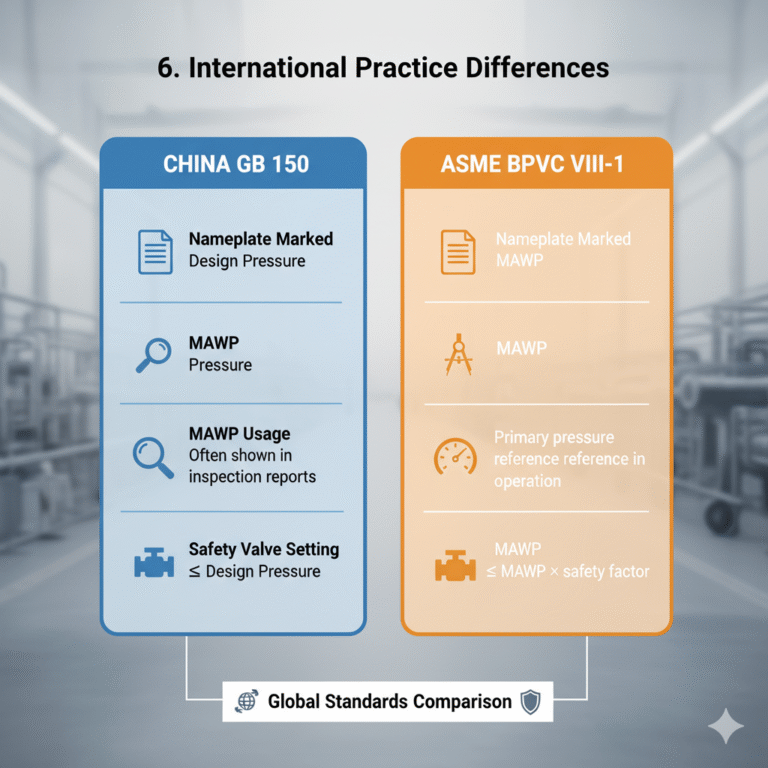In the fields of pressure vessels, heat exchangers, pipelines, and boilers, three pressure-related terms appear frequently:
Operating Pressure
Design Pressure
MAWP (Maximum Allowable Working Pressure)
Although these terms often appear together in drawings, datasheets, and inspection documents, they cannot be used interchangeably. They represent different pressure control levels that determine mechanical safety margins, operating boundaries, and compliance with inspection standards.
This article clarifies their definitions, relationships, and practical engineering implications, supported by standards, calculation logic, and real-world failure cases.

1. Operating Pressure
Operating Pressure is the pressure at which the equipment normally runs.
It is determined by process conditions, not by mechanical strength.
One-sentence memory: Operating Pressure is the pressure during normal operation.
According to GB 150.1-2011:
“The operating pressure is the maximum pressure that may occur under normal operating conditions.”
Characteristics:
Provided by process engineers
Comes from PFD/P&ID steady-state conditions
Does not determine wall thickness
Usually lower than the Design Pressure
Example:
If a distillation column bottoms operate at 1.5 MPa, and the top operates at 0.1 MPa (abs), the system operating pressure range is typically taken based on the maximum operating point (1.5 MPa).
2. Design Pressure
Design Pressure is the mechanical calculation basis used to:
Determine wall thickness
Select valves, flanges, gaskets, and component ratings
Set safety valve pressure
Perform regulatory assessment
One-sentence memory: Design Pressure is the pressure used to calculate and design equipment strength.
It must be higher than the maximum possible operating pressure, considering:
Static liquid head
Process fluctuations
Temperature effects
Design safety margins
Calculation Example:
| Item | Pressure (MPa) |
|---|---|
| Normal operating pressure | 1.60 |
| Static liquid head | 0.10 |
| Process fluctuation | 0.05 |
| Safety margin | 0.10 |
| Design Pressure | ≈ 1.85 → Rounded to 2.0 MPa |
So, the vessel would be designed for 2.0 MPa, not 1.60 MPa.

3. MAWP
MAWP represents the maximum safe pressure the equipment can withstand at the design temperature, considering the weakest point in the structure.
One-sentence memory: MAWP is the true physical upper limit the equipment can safely withstand.
As per ASME BPVC VIII-1:
“MAWP is the maximum internal pressure at which stress does not exceed the allowable stress at design temperature.”
MAWP is calculated after fabrication, considering:
Actual measured thickness
Welding quality
Material properties
Example:
A vessel designed at 2.0 MPa is fabricated with thicker-than-minimum wall thickness. After recalculation:
MAWP = 2.15 MPa
The nameplate stays 2.0 MPa, but the equipment can physically withstand 2.15 MPa.
4. The Relationship Between the Three
| Parameter | Who Determines It | Appears In | Role | Typical Value Level |
|---|---|---|---|---|
| Operating Pressure | Process Engineers | PFD / P&ID | Normal running reference | Lowest |
| Design Pressure | Mechanical / Vessel Engineer | GA drawings / Nameplate | Basis for strength calculation | Middle |
| MAWP | Fabricator / Inspection Body | Inspection report / Datasheet | Physical structural limit | Highest |
Mandatory Safety Relationship:
Operating Pressure ≤ Design Pressure ≤ MAWP
These form a three-layer safety boundary:
Operating Layer: What the unit actually runs at
Design Layer: What calculations are based on
Physical Limit Layer: What the steel can truly withstand

5. Common Engineering Mistakes
| Mistake | Consequence |
|---|---|
| Treating Design Pressure as operating limit | Fatigue damage & crack initiation |
| Ignoring static head in tall vessels | Wall rupture near thin upper sections |
| Assuming MAWP = Safety Valve Setting | May lead to illegal overpressure operation |
| Not re-evaluating MAWP during corrosion | Aged vessels = lower MAWP = higher risk |
6. International Practice Differences
| Item | China GB 150 | ASME BPVC VIII-1 |
|---|---|---|
| Nameplate marked pressure | Design Pressure | MAWP |
| MAWP usage | Often shown in inspection reports | Primary pressure reference in operation |
| Safety valve setting | ≤ Design Pressure | ≤ MAWP × safety factor |

7. Final Insight
Operating Pressure defines what happens in reality.
Design Pressure sets the engineering calculation boundary.
MAWP defines the physical and legal safety limit.
Mature engineers do not only “calculate pressure” — they understand the boundaries between them.
